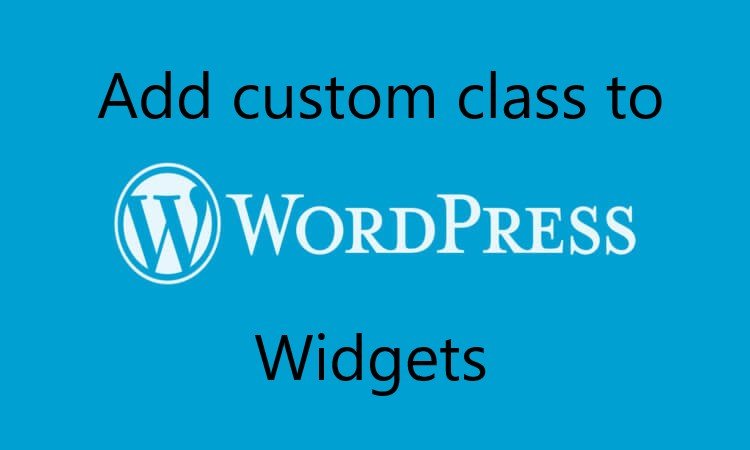Sometimes we come across situations where we are in a desperate need to add custom classes to the WordPress widget specifically to the individual elements to meet some specific design or functionality requirements. I was facing the same issue and ended up spending hours in searching for a feasible solution. And, after going through so many online articles and posts and spending hours. I came across a solution that I thought to share with you that might help saving your efforts. Let’s know how to add custom class to WordPress widgets.
Table of Contents
In this blog, we delve into the concept to add custom class to WordPress widgets and their significance. You will also learn about the process of adding custom classes to WordPress widgets and the benefits of doing so. Additionally, the article will address the issue of adding multiple custom classes. Furthermore, you will know the importance of adding custom classes to any widget in WordPress.
What is Custom Class in WordPress Widgets?
A custom class in WordPress widgets refers to a user-defined CSS class that can be added to the widget’s HTML output. This allows developers to apply custom styles to the widget, making it easier to change the appearance of the widget without affecting other elements on the page.
In addition, the custom class can be added in the widget’s settings page in the WordPress administration area. It can be accessed in the widget’s template file using the ‘widget_class’ argument.
Related: Top 10 SEO Plugins for WordPress Website
How to Add Custom Class to WordPress Widgets?
To add custom class to WordPress widget, follow these steps:
1. Log in to the WordPress administration area and navigate to the widget’s settings page, typically found under Appearance > Widgets.
2. Locate the widget you want to add a custom class to as well as open its settings.
3. Look for a field labeled “Custom Class” or something similar. If it’s not available, check the widget’s documentation or contact the widget’s developer.
4. Enter the name of the custom class in the “Custom Class” field and save the changes to the widget.
5. In your WordPress theme’s style.css file, add styles for the custom class using CSS syntax.
6. Refresh your website to see the changes.
Moreover, not all WordPress widgets have the option to add a custom class. The ability to add a custom class is determined by the widget’s developer and may vary from widget to widget. If a widget does not have a “Custom Class” field, it cannot be customized using custom classes.
Let’s know how to use code to add cumtom class to WordPress Widgets.
Register a WordPress Widget
Add the following piece of code to your plugin or theme functions.php file.
if ( function_exists('register_sidebar') ) {
$mySidebar = array(
'id' => 'yourUniqueSidebarId',
'before_widget' => '<div class="widget %2$s">',
'after_widget' => '</div>',
'before_title' => '<h2 class="widget_title">',
'after_title' => '</h2>',
'name'=>__( 'Your Sidebar Name', 'textdomain' ),
);
register_sidebar( $mySidebar );
}Add Custom Class To Your Widget Element
Adjust your conditional checks as per need. You can check and apply it for all “Image” widget elements. You can further restrict to a specific sidebar widget using sidebar id.
if(!is_admin()){
add_filter( 'dynamic_sidebar_params', 'my_add_widget_class' );
function my_add_widget_class( $params ) {
if(!empty($params) && $params[0]['widget_name']=='Image' && $params[0]['id']=='yourUniqueSidebarId'){
$params[0] = array_replace($params[0], array('before_widget' => str_replace("widget_media_image", "widget_media_image sg-footer-ter", $params[0]['before_widget'])));
}
return $params;
}
}Place this script in your functions.php file
This is tested code and I hope it helps you as well. Good luck.
Also read: How to Implement Infinite Pagination in WordPress?
Why Do We Need to Add a Custom Class to WordPress Widgets?
By adding a custom class to WordPress widgets, developers can apply custom styles to the widget, making it easier to change the appearance of the widget without affecting other elements on the page. This makes it easier to create unique and customized widgets for different pages as well as posts on a website.
We add custom classes to WordPress widgets for the following reasons:
1. Customization
By adding a custom class to a widget, we can apply custom styles to the widget using CSS. This makes it easier to change the appearance of the widget without affecting other elements on the page.
2. Separation of styles
By using custom classes, we can keep the styles for the widgets separate from the styles for other elements on the page, making it easier to maintain the styles for the widgets as well as reducing the risk of conflicts with other styles.
3. Reusability
Custom classes can be used for multiple widgets on the same website, making it easier to apply the same styles to multiple widgets, making it easier to create a consistent look as well as feel across the website.
4. Better organization
Custom classes help to organize the styles in the CSS files, making it easier to find and modify the styles for the widgets in the future.
Can Multiple Custom Classes be Added to a Single Widget?
Yes, you can add multiple custom classes to a single widget. To add multiple custom classes to a widget, simply separate each class name with a space in the “Custom Class” field. For example, if you want to add two classes named “class1” and “class2” to a widget, you would enter “class1 class2” in the “Custom Class” field.
Therefore, keep in mind that the styles for each custom class must be defined separately in the CSS file, and the styles for each class will be applied to the widget in the order they are defined.
Can a Custom Class be Added to Any WordPress Widget?
Not all WordPress widgets have the option to add a custom class. The ability to add a custom class is determined by the widget’s developer and may vary from widget to widget. If a widget does not have a “Custom Class” field, you can’t customize it using custom classes. In such cases, we recommend to check the widget’s documentation or contact the widget’s developer for more information.
Also read: How to Calculate Read Time of an Article or Textual Content?
Conclusion
Hence, adding a custom class to WordPress widgets is a powerful way to customize the appearance of widgets and make it easier to manage styles on your website. By using custom classes, developers can apply custom styles to widgets, separate styles for different widgets, and create a consistent look and feel across the website.
While not all widgets may have the option to add custom classes, for those that do, it is a simple process that involves entering the class name in the “Custom Class” field and defining the styles for the class in the CSS file. In addition, with the ability to add custom classes, developers have more control over the appearance and behavior of widgets, making it easier to create unique and customized websites.



